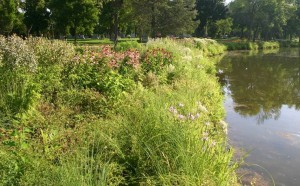Lakefront landscaping is key to water quality. Listen up:

Keep your lake healthy by letting the lakeshore get in touch with its wild side! (via Fred Rozumalski)
You might like the look of a clean-cut lawn, but if you have lake front property, experts say not to mow all the way to the shoreline.
Rozumalski: “The most important thing you can do for your lake is to create a buffer zone, and this is a patch of native plants along the lakeshore.”
That’s landscape architect Fred Rozumalski. He says even modest buffers can trap pollutants such as fertilizers and loose soils before they reach a lake.
While the roots of plants in a buffer zone prevent erosion, the flowers and branches provide valuable habitat for wildlife.
And these buffers don’t need to keep people away. Grass paths can provide eco-friendly access to the lake.
Hear More:
Listen to Fred Rozumalski describe the three steps to lakescaping.
Get Schooled:
- Learn more from the Minnesota DNR.
- Get the facts about lakescaping with this fact sheet from Clear Choices Clean Water
The Fine Print:
- This segment was produced with Cornell’s Atkinson Center for a Sustainable Future, and supported by agreement with New York Sea Grant, funds provided by the Environmental Protection Fund under the authority of the New York Ocean and Great Lakes Ecosystem Conservation Act. Any opinions, findings, conclusions or recommendations expressed in this broadcast are those of the originators and do not necessarily reflect the views of Stony Brook University or New York Sea Grant.




